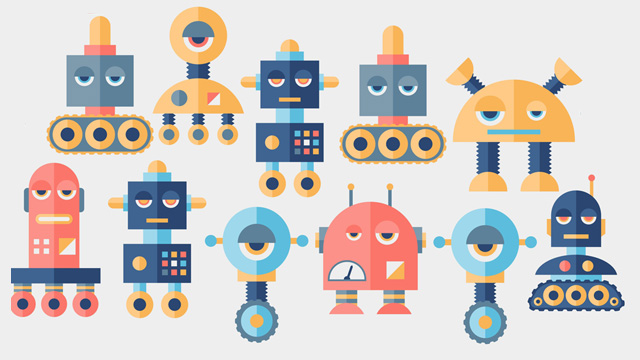 Robotics is a broad industry, encompassing many different technologies and applications. Essentially, however, this field of study examines and furthers the science of mechanisms with sophisticated motor and behavioral skills. Computer technology is an integral part of robots, used to control the movement and behavior of these machines. Electrical circuitry and mechanical function are other sciences incorporated in the design, function, and maintenance of robotic instruments.
Robotics is a broad industry, encompassing many different technologies and applications. Essentially, however, this field of study examines and furthers the science of mechanisms with sophisticated motor and behavioral skills. Computer technology is an integral part of robots, used to control the movement and behavior of these machines. Electrical circuitry and mechanical function are other sciences incorporated in the design, function, and maintenance of robotic instruments.
Categories of Robotics
Robotics is divided into three categories: industrial, mobile, and biomimetic. However, contained within these three areas of robotics, one finds a tremendous number of robotic applications in all areas of society. From helping physicians conduct surgery, to assisting welders reduce the physical stress of their jobs, robots are found in practically every type of industry. Robotic Technician lists some of these robot-assisted industries to include, “..the appliance, automotive, aerospace, consumer goods, logistics, food, pharmaceutical, medical, foundry, and plastics industries as well as multiple applications including material handling, machine loading, assembly, packaging, palletizing, welding, bending, joining, and surface finishing.”
Industrial Robots
Industrial robots are often used in factories or plant facilities to help with the manipulation or construction of products. A robot that moves pallets of wood from one end of a building to another is an example of an industrial robot. Industrial robots are often employed to build automobiles, and other manufactured items. These tools often cut, shape and join materials together. Above all, industrial robots help their human controllers reduce dangerous, repetitive movement of employees. In that way, they help to eliminate at-work injuries and accidents.
Mobile Robots
Mobile robots are machines that can move around on land, water, or in the air. The most common example of a mobile robot would be a child‘s remote control toy car. Remote control cars are often controlled by radio waves, as the operator navigates the toy’s path. Many industries including farming, and oceanography use remotely operated vehicles or ROVs.
Mobile robotics, such as the drones used by the American military to gather information or deliver weapons, must be able to avoid other objects and navigate effectively. This means that these robots must have vision or other sensory capability, so that they can assess their surroundings effectively. NASA uses mobile robots such as the Sojourner to gather information about other planets.
Biomimetic Robots
The military, medical, and entertainment industry use biomimetic robots for many different reasons. Biomimetic robots are inspired by mammal, insect, or amphibian anatomy. Scientists may study the design of the legs of horses, or some other animal, with the objective of constructing robots that mimic that movement. For example, scientists may develop a robot that moves with snakelike motion to investigate underground areas, or disaster sites.
Very small biomimetic robots may be used by the medical profession to help diagnose illnesses. Ants, bees, caterpillars, rats, hummingbirds, and dogs have all been used as models for biomimetic robots for the study of different modes of locomotion and navigation. Artificial muscles and tendons are examples of biomimetic technology that can help the injured regain functionality through prosthetic limbs.
Artificial intelligence
Artificial intelligence (AI) enables robots to adapt to their environment, and behave in way that is predictable or calculated – that is, in a way that a human would. A robot with effective AI can solve problems, reason, and learn. Machines that think for themselves are all around us. Voice recognition technologies are one example. Closed-circuit televisions (CCTVs) can now watch and analyze peoples’ motions to detect danger or potential violence.
According to the Association for the Advancement of Artificial Intelligence (AAAI), many exciting developments in AI are just around the corner. This organization predicts that by 2050, AI systems that rival the human brain will exist. If AI develops as expected, robots will only become more useful and sophisticated tools that will benefit society as never before.
References
Coleman, Casey. (2011). “Amazing Robotics.” Around the Corner. Innovation in the Business of Government: A GSA Blog. http://gsablogs.gsa.gov/innovation/2011/01/12/amazing-robotics/
“Types of Robots.” Rover Ranch. NASA. http://prime.jsc.nasa.gov/ROV/types.html
“Robot Technicians.” (2014). Tech Directions. 72(7). pp. 24-5.
MITMeche: Biomimetic Robots Lab. (2014). http://biomimetics.mit.edu:8100/wordpress/
Drake, Nadia. (2013). “The Coolest and most Terrifying Biomimetic Robots.” Wired. May, 2.
“Rise of the Robots.” (2014). The Economist. 410(8880). p. 13.
Association for the Advancement of Artificial Intelligence (AAAI). (2014)